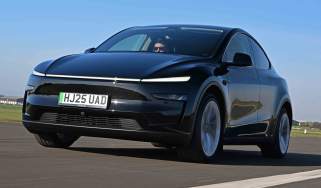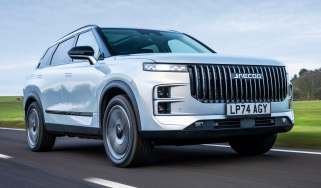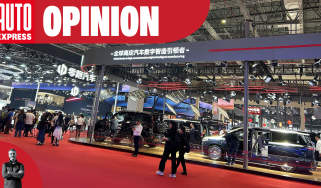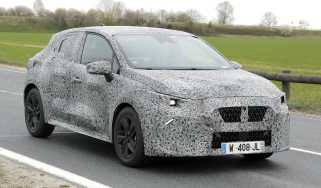Jaecoo 7 review
Latest Chinese arrival aims to deliver upmarket space at a competitive price
Our opinion on the Jaecoo 7
Jaecoo will be an unfamiliar name to most UK buyers, but it’s part of a Chinese group which, worldwide at least, is much better known. Jaecoo is a sub-division of Chery and was created as an SUV maker for export markets. Chery also owns the Omoda brand, which is another recent newcomer to Britain. Indeed, the Jaecoo 7 and Omoda 5 share the same platform.
In both instances, loads of kit is provided as standard, but unlike Omoda, Jaecoo is pitched with a little more upmarket intent. That’s evident in the styling; the imposing front grille is hardly shy or retiring, while other areas – particularly at the back – have more than a hint of the Range Rover Velar. This all comes at a price that pits this medium-sized SUV against smaller models from European and Far Eastern rivals.
| Key specs | |
| Fuel type | Petrol and plug-in hybrid |
| Body style | Small SUV |
| Powertrain | 1.6-litre, 4cyl petrol, front-wheel drive 1.6-litre, 4cyl petrol, four-wheel drive 1.5-litre, 4cyl petrol plus 1x e-motor and 18.3kWh battery, front-wheel drive |
| Safety | 5 stars (Euro NCAP, 2025, applies to the PHEV version tested) |
| Warranty | Up to seven years/100,000 miles |
About the Jaecoo 7
Prices for the Jaecoo 7 range from just over £30,000 and rise to a little over £35,000, although there are discounts to be found with our Find a Car service. For the money, you get a car from one of the wave of Chinese brands that are landing in the UK, and it’s one which is priced at the level of a small SUV, but similar in size to mid-size models.
Jaecoo is a brand owned by Chery, which is China’s biggest car exporter, and has been for the past 20 years or so. In 2024, it sold more than 2.6 million cars, which is more than the BMW Group managed to shift.
While Chery also owns Omoda, that brand is designed with affordable luxury in mind, while Jaecoo is meant to be seen as the generally more premium marque. The Jaecoo 7 has a more rugged aesthetic and is attempting to go after the likes of the Audi Q3, BMW X1 and MINI Countryman. However, we doubt Jaecoo can steal sales away from those particular models at this early stage.
There are just three variants to choose from. The base model features a 1.6-litre petrol engine and seven-speed automatic gearbox, and comes in Deluxe trim, which features a 13.2-inch central touchscreen, 10.25-inch digital driver’s display, wireless smartphone charging, a surround camera system, heated front seats, LED ambient lighting, a full-length panoramic sunroof and more than 20 advanced driver-assistance systems.
For around £4,000 extra, you can upgrade to Luxury specification, which has the same engine and gearbox combo, but also adds four-wheel drive. Inside there’s a slightly larger 14.8-inch touchscreen, a head-up display, an eight-speaker Sony sound system, ventilated front seats, a heated steering wheel, heated rear seats and a four-way adjustable driver’s seat, among other kit.
The plug-in hybrid Jaecoo 7 SHS (Super Hybrid System) is only available in Luxury trim, and features a 1.5-litre petrol engine that works with an electric motor and 18.3kWh battery to deliver up to a claimed 403mpg and 56 miles of pure-electric driving.
Performance & driving experience

| Pros | Cons |
|
|
Slightly dull handling isn’t the end of the world, but elsewhere the Jaecoo 7 trails most rivals for sophistication. At low speeds around town, the ride can be a touch fidgety, but the petrol model isn’t quite as bouncy as the heavier plug-in hybrid. The steering is very light, which makes parking fairly easy, with low-speed manoeuvres aided by the surround-view camera. This includes a system that can provide images of the road beneath the wheels, so you know how close they are to kerbs and other obstacles.
Keen handling isn’t the most important consideration for a family car, and in this respect, the Jaecoo is just about adequate. Aside from the lifeless steering and the body getting thrown around by mid-bend bumps, it’s a fairly neutral and predictable – if slightly sluggish – car to drive through corners. But it’s the ride that is the major issue. The car has a fairly regular bounce at higher speeds, and shocks are transferred into the cabin more noticeably than in other rivals.
Having a long seventh gear is normally a good thing for motorway work, because it means at a cruise the engine revs drop low, both improving refinement and reducing fuel consumption. There is a trade-off when a car is short of performance, though, and that’s certainly the case with the Jaecoo 7.
At 70mph, the engine settles down to a fairly hushed 2,000rpm in seventh gear, but whenever you need any throttle – such as on an incline – the gearbox will kick down to sixth to maintain its speed, only to shift up again too early, which in turn forces it to kick down and repeat a rather frustrating process. On steeper inclines, it occasionally drops down to fifth gear, so progress isn’t very smooth as a result. It’s a bit of a shame, because road noise and engine noise are as muted as in most other similarly priced petrol-powered cars.

Performance, 0-60mph acceleration and top speed
The cheapest model in the range is equipped with a 1.6-litre turbocharged petrol engine, which makes 145bhp and 275Nm of torque. Switch the engine on, and it sounds a little noisy at idle. It’s also loud on other occasions, but these aren’t always its own doing; instead, it’s the fault of the seven-speed automatic gearbox. The laggy transmission is lethargic when moving off from rest, and makes the four-cylinder petrol unit groan as it pulls away. You can take manual control of the shifts, but doing so doesn’t improve things.
Given its claimed power figures, the Jaecoo 7 never feels as lively as you might expect. A Volkswagen Group car with a 1.5 TSI petrol engine offers similar power and torque stats, but feels quicker – even in models that match the Jaecoo’s size.
The 7 is available with four-wheel drive, but this will be a tough model for most buyers to justify. The extra driven wheels blunt performance even more: the 0-62mph time increases by 1.5 seconds to 11.8 seconds, and CO2 emissions rise from 169g/km to 182g/km. It also costs around £3,500 more than the front-wheel-drive version, although it does get more standard kit.
The plug-in hybrid version offers much better straight-line speed than the standard petrol model. Thanks to its 18.3kWh battery, the PHEV can cover an impressive 56 miles in electric-only mode, based on WLTP data. The engine doesn’t cut in too often, and when the battery level drops low, the engine fires up to recharge it.
| Model | Power | 0-62mph | Top speed |
| Jaecoo 7 1.6T Deluxe | 145bhp | 10.3 seconds | 112mph |
| Jaecoo 7 1.6T Luxury AWD | 145bhp | 11.8 seconds | 112mph |
| Jaecoo 7 1.5 PHEV Luxury | 201bhp | 6.1 seconds | 108mph |
MPG, emissions and running costs

| Pros | Cons |
|
|
For all of the engine’s issues, by far the worst problem with the pure petrol-powered Jaecoo 7 is its fuel consumption. Over the course of 300 miles or so, we averaged just over 27mpg, which is a figure that would leave us underwhelmed in a performance car with more than double the power – never mind a model where running costs should be a priority.
The absolute best we recorded on any trip was 44mpg, but that was through a 50mph average speed section of motorway. Up the ante to 60mph or 70mph, and you’re looking at mid-to-high 30s mpg – or roughly the same as the 37.7mpg that the Jaecoo 7 can achieve in combined WLTP testing. On a similarly gentle motorway run, a Skoda Kamiq 1.5 TSI is capable of more than 50mpg – and provides stronger performance.
When equipped with a petrol engine, the Jaecoo 7 is going to make the most sense for private buyers. At 169g/km of CO2, the front-wheel-drive petrol 7 faces a first-year VED rate of £1,360. Given that the initial cost is usually swallowed up by a monthly payment of a finance deal, it’s not the end of the world. More relevant is the second-year cost, which comes to £195.
The all-wheel-drive model falls into a lower insurance group than the front-wheel-drive variant, with the pair in groups 21 and 22, respectively. The plug-in hybrid, meanwhile, is in group 31.
Initial estimates suggest that the Jaecoo 7 will deliver residual values that are competitive with its rivals. After three years or 36,000 miles, the base petrol model is predicted to hold on to 48.5 per cent of its original value. Against new cars costing a similar amount, the Jaecoo 7 will have better residuals than a Nissan Juke, similar to a Ford Puma and lie slightly behind a Renault Captur.
| Model | MPG | CO2 | Insurance group |
| Jaecoo 7 1.6T Deluxe | 37.7mpg | 169g/km | 21 |
| Jaecoo 7 1.6T Luxury AWD | 35.3mpg | 182g/km | 22 |
Electric range, battery life and charge time
For the plug-in hybrid model, Jaecoo has designed the powertrain to never let its 18.3kWh battery run flat. Of course, it achieves this by having the engine generate energy, but it means you’ve always got juice in the battery for running in EV mode, such as through town. According to the brand, you should be able to cover 745 miles on a full battery and a single tank of petrol.
However, even if the Jaecoo 7 SHS was as efficient as the brand claimed, you might never realise this because the car only shows how it has performed over the previous 50km (31 miles).
If you want to make the most of the EV driving capabilities, fully recharging the Jaecoo 7 SHS using a standard home wallbox takes nearly seven hours. It can be plugged into a public DC rapid charger, but these are much more expensive and with a maximum charging speed of 40kW, a 30 to 80 per cent top-up still takes 40 minutes.
| Model | Battery size | Range | Insurance group |
| Jaecoo 7 1.5 PHEV Luxury | 18.3kWh | 56 miles | 31 |
Design, interior & technology
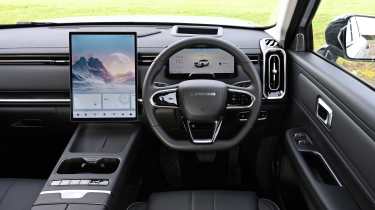
| Pros | Cons |
|
|
While some Chinese newcomers, including its Chery group stablemate, the Omoda 5, look a little anonymous, the Jaecoo has some features that help it stand out from the crowd. To either side of that huge front grille lie headlights with square LED elements, which look almost Audi-like.
Elsewhere, there’s clearly a lot of Range Rover influence, even down to small details such as the electrically retractable door handles. One thing that lets the side down are the 19-inch alloy rims, though, which make the 7 look rather ‘under-wheeled’.
The Land Rover design inspiration continues inside. The steering wheel’s squared-off central boss and chunky spokes have more than a whiff of Evoque about them, while the metal-effect door pulls with exposed screw heads remind us of the Land Rover Defender. The overall dash design is fairly minimalist, but too much so – there are very few physical switches for useful features such as climate control or even a rear window heater. A huge panoramic sunroof helps to make the cabin feel light and airy, though.
If you stick with the petrol engine, the dashboard features an oversized gear selector that looks like a spare part from a Transformer, a large drive-mode dial and some physical shortcut buttons. The plug-in Jaecoo 7 SHS has a column-mounted gear selector and a row of buttons for the hybrid powertrain on the centre console. Soft-touch plastics help to give an impression of reasonable perceived quality at first glance, and overall, it feels on a par with other cars available for similar cash.
One of the Jaecoo’s key strengths is its generous standard kit. Every model gets 19-inch alloy wheels, LED headlights, a 10.25-inch instrument cluster, satellite navigation, synthetic leather upholstery and heated seats. Upgrade to the Luxury trim (available on four-wheel-drive petrols and the PHEV) and you gain an eight-speaker Sony sound system, ventilated front seats and heated rear seats, a head-up display and a heated steering wheel.
There is some oddness to the in-car interfaces, though. When you change drive modes, for example, the in-car assistant will tell you so; switching to Sport will cause a voice to announce “Sport Mode!”. It’s a charming quirk initially, but we suspect that it would become a bit irritating after a while. The digital driver’s display, meanwhile, looks sharp, but its information is haphazardly scattered across its screen.
Many cars have ambient lighting, and the Jaecoo 7 is no exception. You can select from a range of colours to personalise the gentle hue that glows from several places on the doors and the dash.
Less conventional is a feature which makes the ambient lighting flash with the music. We use ‘with’ in the loosest sense – when we tried it, it didn’t really seem to keep time to the rhythm, but flashed on and off and changed colours at random. This is every bit as distracting as you might think.
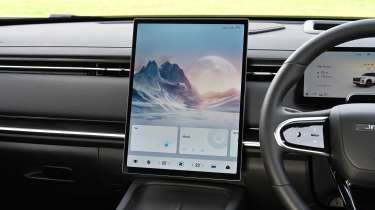
Sat-nav, stereo and infotainment
The base petrol Jaecoo 7 is equipped with a 13.2-inch screen, slightly down on the 14.8-inch display in the four-wheel-drive and PHEV versions. As with the larger option, it’s a little frustrating to use. While the screen is fairly responsive and the loading times are okay, the interface isn’t so great.
Small icons on the home page don’t make the most of the large display, and when pairing Android Auto or Apple CarPlay, the native controls disappear completely. That includes the heating, which can only be adjusted through the screen, so you have to get out of your smartphone system back to the home screen to adjust the temperature, for example.
Boot space, comfort & practicality
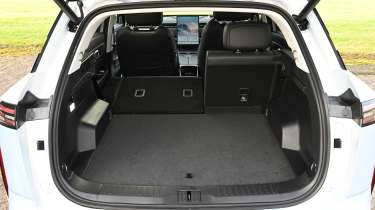
| Pros | Cons |
|
|
The Jaecoo 7 is a large car for the money, and those generous exterior proportions translate into lots of space inside. But some smaller B-segment cars run it close for cabin capacity, and take up less space on the road.
A high driving position and a decent range of adjustment for the seats and steering wheel are plus points, but the driving position feels a touch offset, with your feet a little further to the right than seems natural. Comfortable headrests are very wide and gently curved, which, as with some of the exterior styling, feels inspired by certain Range Rover products. Less impressive is the view out of the back; the rear window is tiny.
Storage space isn’t in short supply, with the Jaecoo offering a deep and cooled central bin between the front seats. Ahead of that, there is space for two smartphones (one spot has cooled wireless charging) on a raised centre console. Below this is a large storage area. The door bins are wide but a little shallow, yet the glovebox is reasonably roomy. There’s even a small shelf to store a tissue box, and a small slot above it works as a tissue dispenser.
If you regularly need to carry four or more tall people, the Jaecoo is very hard to knock. Compared with most of its similarly priced competition, the 7 has acres of space in the back, mixing an impressive amount of headroom and legroom. The cabin also feels wide enough to accommodate three people without much trouble, but the backrest of the centre seat is extremely hard, so it won’t be as comfortable, unlike the outer seats, which are soft and supportive.
Big doors and ISOFIX points that are easy to access behind large, plastic covers should make it fairly easy to install a child seat in the back. The only criticism is that, considering how much larger on the outside it is than some B-segment rivals such as the Skoda Kamiq, the Jaecoo 7 is not vastly more spacious for occupants.
| Dimensions | |
| Length | 4,500mm |
| Width | 1,865mm |
| Height | 1,680mm |
| Number of seats | 5 |
| Boot space | 412-1,335 litres |
Dimensions and size
The Jaecoo 7 is longer, taller and wider than cars like the MINI Countryman, Nissan Qashqai and Toyota C-HR. It’s similar in length and width to the Hyundai Tucson and Kia Sportage, although the 7 is still taller than both of those rivals.
Boot space
A 500-litre boot is very spacious when compared with cars of a similar price. Access is via a standard powered tailgate, and the load bay comes with a 12-volt socket and a couple of tethering points. The rear seats fold in a 60/40 split, which is fairly typical for the class, but isn’t quite as flexible as the 40/20/40 split used by more premium (and pricier) rivals such as the BMW X1.
Towing
Of the entire Jaecoo 7 range, only the plug-in hybrid PHEV is rated to tow. It can handle up to 1,500kg, which is on par with rivals like the petrol versions of the Hyundai Tucson and Kia Sportage. If you want to tow more, you’ll need something like the 2.0 TDI 150 Volkswagen T-Roc that can pull up to 1,600kg, or the SEAT Ateca 1.5 TSI, which manages even more, at up to 1,800kg.
Safety & reliability
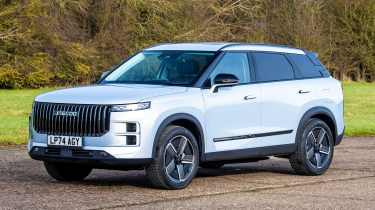
| Pros | Cons |
|
|
Euro NCAP has awarded the Jaecoo 7 its maximum five stars out of five score, putting it ahead of similarly priced four-star rivals like the MG ZS, and Renault Symbioz. If you want an even safer alternative, you’ll have to pay a little bit more and get a Toyota C-HR, which scored higher than the 7 in all categories, except in the safety technology section.
There was one caveat to the 7’s NCAP score, because it was penalised in the side pole and barrier tests due to the side curtain airbag not deploying correctly after getting caught in the C pillar trim. This problem was investigated and has since been rectified. It is also worth noting that this rating only applies to the plug-in hybrid model because that was the only version tested, but we doubt the lighter petrol version would be any less safe.
There is a whole host of standard safety assistance technology provided on the 7, such as adaptive cruise control, blind-spot detection, and emergency lane-keeping.
Being such a new brand in the UK, it’s too early to tell how reliable Jaecoo’s cars will prove to be, but thanks to a seven-year, 100,000-mile warranty, the Jaecoo 7 comes with one of the most comprehensive aftersales packages available, matching the terms offered by Kia, and well beyond most mainstream brands. More impressive is that the entire warranty period is also covered by RAC breakdown cover.
In order to spread the cost of payments, Jaecoo offers owners the option of an interest-free service plan. A three-year charge of around £550 is competitive for a pure-petrol car.
| Key standard safety features | Euro NCAP safety ratings |
|
|
Buying and owning
- Best buy: Jaecoo 7 1.6T Deluxe
The Jaecoo 7 is already so well-equipped that there isn’t much scope for personalisation. It comes down to the five exterior colours, and all but the no-cost white are £600 options, while a contrasting roof adds another £600. We’d suggest sticking with a single colour, because it doesn’t dramatically alter the way the car looks to have a contrasting colour.
Unless you can charge your Jaecoo 7 at home, and you’re a company car driver who would benefit from the lower benefit-in-kind (BiK) costs, we suggest sticking with the least expensive 1.6T Deluxe. It’s more economical and slightly quicker than the four-wheel drive version, and it’s a handy £5,000 less than the plug-in hybrid.
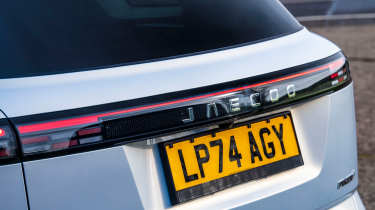
Alternatives
The Jaecoo 7 is aimed as a rival for models such as the Audi Q3, BMW X1 and MINI Countryman, but at a knockdown price. The reality is that it can’t compete with any of these more polished competitors, and we’d consider it more as a budget alternative to the likes of the Hyundai Tucson, Nissan Qashqai and Kia Sportage.
It’s similar to those cars in size, but the price tag pitches the Jaecoo 7 towards the small SUV sector and cars such as the Skoda Kamiq, Renault Captur and Peugeot 2008, while other Chinese models such as the MG HS and even the similar Omoda 5 are rivals.
Jaecoo 7 pictures
Frequently Asked Questions
There’s a long seven-year/100,000-mile warranty for the Jaecoo 7, which matches the longest amount of cover available in the new car market. What’s more, it’s backed up by seven years of roadside assistance, too.







